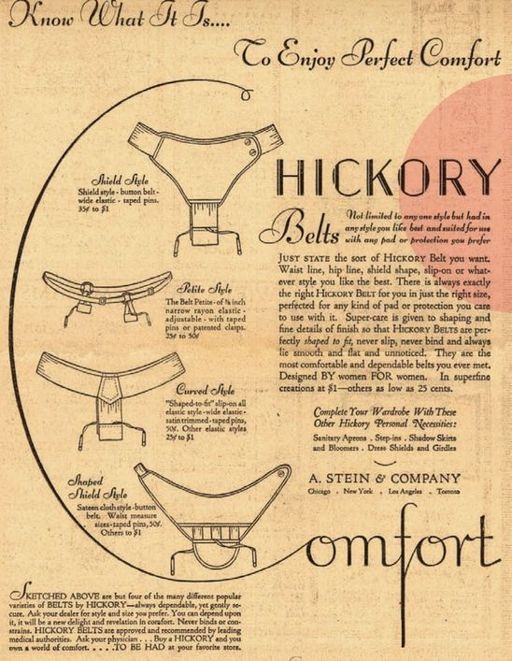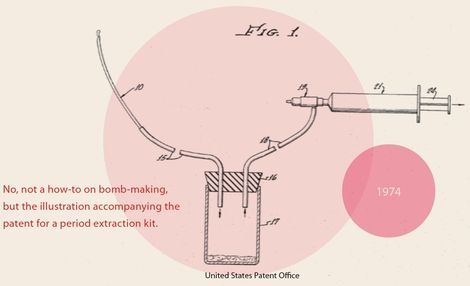Flow: The Cultural Story of Menstruation (14 page)
Read Flow: The Cultural Story of Menstruation Online
Authors: Elissa Stein,Susan Kim
Tags: #Health; Fitness & Dieting, #Women's Health, #General, #History, #Historical Study & Educational Resources, #Politics & Social Sciences, #Women's Studies, #Personal Health, #Social History, #Women in History, #Professional & Technical, #Medical eBooks, #Basic Science, #Physiology

So it was like a shining knight on a sanitary white charger when manufactured menstrual products hit the marketplace, literally affording a “new freedom”to women. In 1896, Johnson & Johnson introduced the very first disposable pad, Lister’s Towels (named for Joseph Lister, a British surgeon who popularized the concept of sterile surgery). To be sure, it took a while for commercial menstrual products to catch on, given what they were and the limits of advertising in such a relatively genteel time. But 1920 finally saw the ratification of the Nineteenth Amendment, which stated: “The right of citizens of the United States to vote shall not be denied or abridged by the United States or by any State on account of sex.” And the same year, Kotex pads went on sale.
Commercial femcare products were soon proliferating, and related advertising was up and running, as well. Yet as is the case with any giddy new revolution, there was a certain measure of morning-after reality. Even with all the newfound freedom Kotex promised, early disposable padswere no walk in the park. They were bulky, uncomfortable, cumbersome, and had to be attached, with safety pins or clips, to elastic belts that one wore around the waist. The whole getup was unwieldy and annoying, with major slippage potential, not to mention many opportunities for sudden, unexpected leaking. In the 1930s, commercial tampons were introduced, and they, too, were beset by problems, being clunky, awkward to insert, and not even especially absorbent. Still, these early prototypes at least beat bleeding into one’s crummy petticoat, and early-twentieth-century women must have surely basked in the heady glow of this fledgling political and menstrual freedom.

But at the same time, society was sneakily working on its own covert agenda. Guess what was introduced the year after women won the right to vote and Kotex hit the stores? The Miss America beauty pageant. Coincidence? From the very start, as if in direct if unconscious response to all those sweaty, noisy, totally undainty suffrage workers, the pageant championed an old-fashioned ideal of femininity. Racy, bobbed haircuts were forbidden, as was any makeup. In fact, anything modern was verboten in the fledgling pageant world, until at last the prototype of Miss America emerged as the squeaky clean, idealized representation of womanhood she is today … still conveying the message that despite any achievements or education, the ideal woman is still, above all, demure and decorative. And while Miss America’s unflagging popularity held steady for years (its annual televised extravaganza was consistently top-rated from its first airing in 1951 through much of the 1960s), conflict was bubbling elsewhere under society’s seemingly placid surface.
In 1963, The Feminine Mystique landed in bookstores, and overnight, Betty Friedan tore a new hole in the illusion that women were fulfilled being merely wives, mothers, and homemakers. In the first chapter, “The Problem That Has No Name,” she wrote: “The problem lay buried, unspoken, for many years in the minds of American women … . As she made the beds, shopped for groceries, matched slipcover material, ate peanut butter sandwiches with her children, chauffeured Cub Scouts and Brownies, lay beside her husband at night—she was afraid to ask even of herself the silent question—‘Is this all?”’

While there were certainly many women who felt Friedan got it all wrong, still others who felt trapped by domesticity found in her message both a kindred spirit and a rallying cry. Thus, the so-called second wave of feminism was launched. With the vote long since sewn up, the women’s liberation movement protested fundamental inequalities and championed everything from parity in wages and the Equal Rights Amendment to fair access to education and abortion rights. Birth control pills became available in the early 1960s, women’s health collectives sprang up as an alternative to the male-dominated medical establishment, and the first edition of that estimable alternative women’s health bible, Our Bodies, Ourselves, came out in 1973. Midwives came back into fashion and the number of natural childbirths rocketed.

Title IX was passed in 1972, which meant schools could no longer discriminate when it came to funding and providing sports and activities for girls. Women’s rights took another significant leap forward in 1973 when the Supreme Court heard Roe v. Wade and legalized abortion in all fifty states, ruling that privacy regarding one’s reproductive system was consistent with the Fourteenth Amendment to the United States Constitution. And while all this was going on, self-adhesive sanitary napkins hit the market.
Not a big deal, you say? Oh, ho-ho … but we beg to differ.
Overnight, restrictive menstrual gear, practically the same kind one’s grandmother had to use—goofy sanitary belts, safety pins and clips, special panties, oversize pads—became singularly obsolete, a thing of the past. With names like New Freedom, Carefree, and Stayfree, it was clear that change was in the air, baby!
Since pads no longer needed to be superlong to be anchored to those clips fore and aft, they were given permission to shrink. What’s more, superabsorbent materials were developed, allowing pad makers to make their product even slimmer and lighter—and far less detectable—than before. New products, like minipads, were invented and became all the rage.
But as women fought discrimination in the workplace and society, there simultaneously developed an unmistakable feminist trend toward negating the feminine, as well. This is when the women’s movement took on all those unsavory “man-hating” connotations that unfortunately linger to this day.
To be fair, there probably was a lot going on along those lines back then. Come to think of it, who could blame women for militantly refusing to come in second anymore, no matter what the price? Yet anything that smacked even faintly of the feminine or girly was soon seen as suspect, even downright counterrevolutionary. Lipstick, anything pink, and being a housewife were viewed with an equally hairy eyeball, whereas navy business suits, big shoulder pads, and not shaving or wearing makeup were suddenly de rigeur. Overnight, Everywoman became Superwoman, implying there was something deeply wrong with you if you couldn’t have it all and do it all. The party line evolved that women were not just equal to but the same as or even better than men: a position that came close to negating biology and natural differences.
Similarly, anything that had to do with menstruation was often disparaged, in some cases even eliminated. In 1971, a feminist reproductive health self-help group came up with a do-it-yourself “period extraction kit,” by which one’s entire period could be hoovered out in mere minutes. Women were urged to get together with a few friends, hop up on the dining room table, and practice extracting each other’s periods. The inventors toured the country, demonstrating the technique at women-only seminars. As eyebrow-raising as it may seem now, it was surprisingly, if briefly, le dernier cri as a fad, not unlike goldfish swallowing or piling into a telephone booth.
And where are we today?
Well, from the early 1990s onward, we’ve been told that we’re hip-deep in feminism’s third wave. So what exactly are today’s feminists fighting for? After all, women already have the right to vote, and in many areas, discrimination and inequality have been, if not eliminated, then at least reduced. Reproductive rights have become a different battlefield with the advent of RU-486, and to make things even more complicated, there’s no longer anything approaching consensus on the ethical nuances of abortion and choice.

PATENTED MENSTRUAL PRODUCTS THAT DIDN’T SET THE WORLD ON FIRE
• A tampon that would let the wearer know when it was almost filled to capacity (patent #7,214,848—2001)
• An intravaginal balloon that would prevent any leaking (patent #6,747,184—2004)
• A tampon with an adhesive string that would prevent it from being seen when wearing a bathing suit (patent #6,679,868—2001)
• A vulvar deodorant system (patent #3,948,257—1976)
• A sanitary napkin with a rear strip that would reside in the user’s intergluteal crevice, aka one’s butt crack (patent #6,613,031—2003)
What’s more, there’s been a generational reaction against feminism’s second wave, which was in fact created by and geared toward middle-class, white, college-educated women. The second wave didn’t pretend to represent minorities, or touch on vital global, class, or sexuality issues. The third-wave feminist issues seem to be more about individual empowerment and personal decisions about everything from consumer choices to sexual expression than they are about any single, overriding ideology of what it means to be female. Perhaps appropriately, commercial femcare also appears to be riding something of a third wave, as well.
Thanks to menstrual suppression drugs, we can now choose how often we menstruate, if at all. Yet this raises numerous questions, from health risks to problems with potential fertility. And we wonder: Is this one giant leap forward for womankind—freedom from hormonal shifts, bleeding, the risk of unplanned pregnancy? Or a step backward—that by ridding ourselves of an intrinsic part of being female, we’re just trying to make ourselves more like men? Are all periods a problem and is ending them genuine empowerment? Or is this just another shrewd, short-sighted corporate based on making us hate our own bodies?
We’re raising a generation of girls for whom girl power is taken for granted, and so maybe it’s no surprise that this is where we are. In essence, we’re handing young women the opportunity to change the way their bodies work, erasing something that’s been a fundamental female experience since the first humans stood up from all that primordial goo. While we believe women should be free to do what they want with their bodies, we’re nevertheless disturbed by the underlying message being sold to us wholesale, no questions asked … and all for a lousy buck.
Sure, it’s progress. We’re just wondering if it’s in the right direction.
